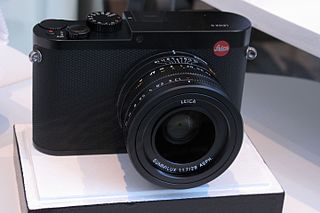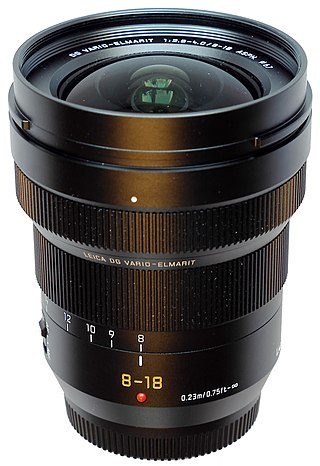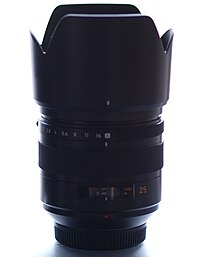
The Four Thirds System is a standard created by Olympus and Eastman Kodak for digital single-lens reflex camera (DSLR) and mirrorless camera design and development.

The Lumix DMC-L1 is Panasonic's first DSLR camera, and was announced in February 2006. This camera adheres to the Four Thirds System lens mount standard, making it the first non-Olympus Four Thirds camera, and thus confirming that the Four Thirds System is a semi-open standard such that compatible camera bodies can be built by different companies.
Walter Mandler was a lens designer of Ernst Leitz Canada in Midland, Ontario. Mandler is credited with the design of more than 45 Leica lenses for the Leica rangefinder cameras and Leica SLR cameras.

The name Noctilux is used by Leica to designate their camera lenses with the widest maximum aperture. Lenses with that name have been in production since 1966. So far all Noctilux lenses have been made for the Leica M mount.

The Micro Four Thirds system is a standard released by Olympus and Panasonic in 2008, for the design and development of mirrorless interchangeable lens digital cameras, camcorders and lenses. Camera bodies are available from Blackmagic, DJI, JVC, Kodak, Olympus, Panasonic, Sharp, and Xiaomi. MFT lenses are produced by Cosina Voigtländer, DJI, Kowa, Kodak, Mitakon, Olympus, Panasonic, Samyang, Sharp, Sigma, SLR Magic, Tamron, Tokina, TTArtisan, Veydra, Xiaomi, Laowa, Yongnuo, Zonlai, Lensbaby, Venus Optics and 7artisans amongst others.

The Panasonic Lumix G 20mmf/1.7 lens is a pancake-style prime lens for Micro Four Thirds system cameras. In the Micro Four Thirds format, it is slightly wider than normal. It was the prime-lens option available with the GF1.

The Panasonic Lumix G 14mmf/2.5 lens is a pancake-style prime lens for Micro Four Thirds system cameras. In the Micro Four Thirds format, it is moderately wide. As of its late-2010 release, it is claimed by Panasonic to be the lightest interchangeable digital-camera lens. It is the prime-lens option available with the Panasonic GF2 and GF3, and available separately.

The Panasonic Leica DG Summilux 25mmf/1.4 lens is a normal lens for Micro Four Thirds system cameras. It is co-branded between Leica and Panasonic, built in Japan under Leica management.

The Leica Q is a full-frame fixed-lens camera announced by Leica on June 10, 2015. The Leica Q2 was announced in March 2019.

The name Summicron is used by Leica to designate camera lenses that have a maximum aperture of f/2 after 1953 and to present day.

The Leica SL is a full-frame mirrorless interchangeable-lens camera announced by Leica Camera AG on 20 October 2015. The SL is promoted as a camera system for professional applications. Beside the Leica S-System, the Leica SL-System is the 2nd professional camera system in the company's product portfolio.

Nocticron is the brand name of Leica lenses with an extreme speed of f/1.2. Because of the large aperture size and its image stabilisation system it is possible to take images with relatively short exposure time especially in available light situations. Together with the high number of nine diaphragm blades the lens creates a strong and pleasant bokeh.
The Panasonic Leica D Vario-Elmar 14-150mm F3.5-5.6 Asph Mega OIS is an interchangeable camera lens announced by Panasonic on March 7, 2007. Since it has been released, it is only produced in small qualities, this makes this product quite special. It features the Four Third Systems to assure its compatibility with different camera models.

The Panasonic Lumix G 25mm F1.7 ASPH is a fixed focal length interchangeable camera lens announced by Panasonic on September 2, 2015.

The Panasonic Leica DG Vario-Elmar 100–400 mmf/4.0-f/6.3 lens is a digital compact telephoto zoom lens for Micro Four Thirds system cameras. It is a varifocal lens branded with the German label Leica, but is currently manufactured in China by Panasonic, previously Japan.

The Leica L-Mount is a bayonet mount developed by Leica Camera AG for interchangeable-lens autofocus digital cameras.

The Panasonic Leica DG Vario-Elmarit 8–18 mmf/2.8-f/4.0 lens is a digital compact ultra wide angle lens for Micro Four Thirds system cameras. It is a varifocal lens branded with the German label Leica, but manufactured by Panasonic in Japan.

The name Summilux is used by Leica and Panasonic Lumix to designate camera lenses that have a maximum aperture of less than f/2, typically f/1.4, but greater than f/1.0. The lens has been in production since 1959 and carries on to the present day.

The name Summarit is used by Leica to designate camera lenses that have a maximum aperture of f/2.4. The name has been in used since 1949.


















